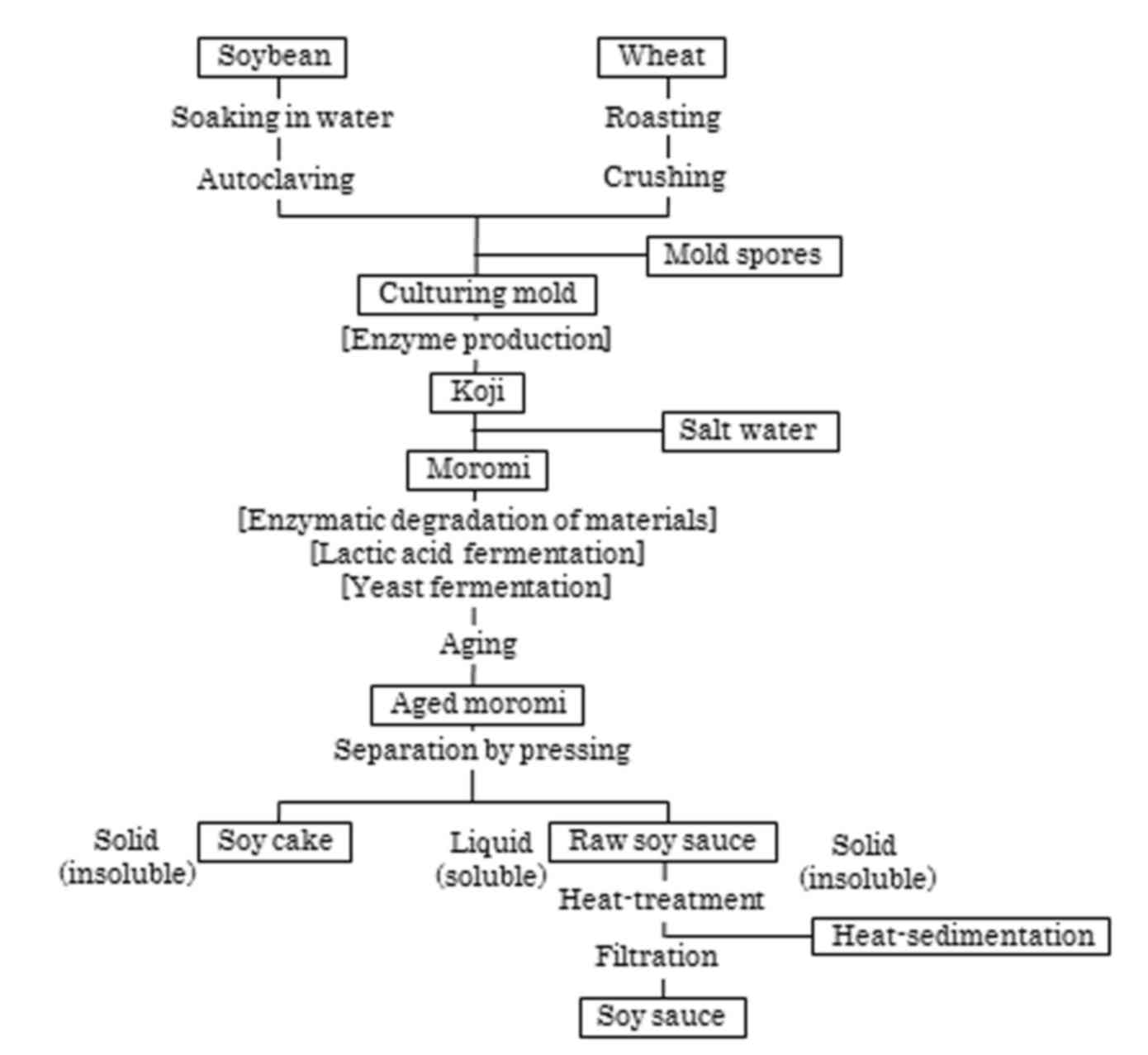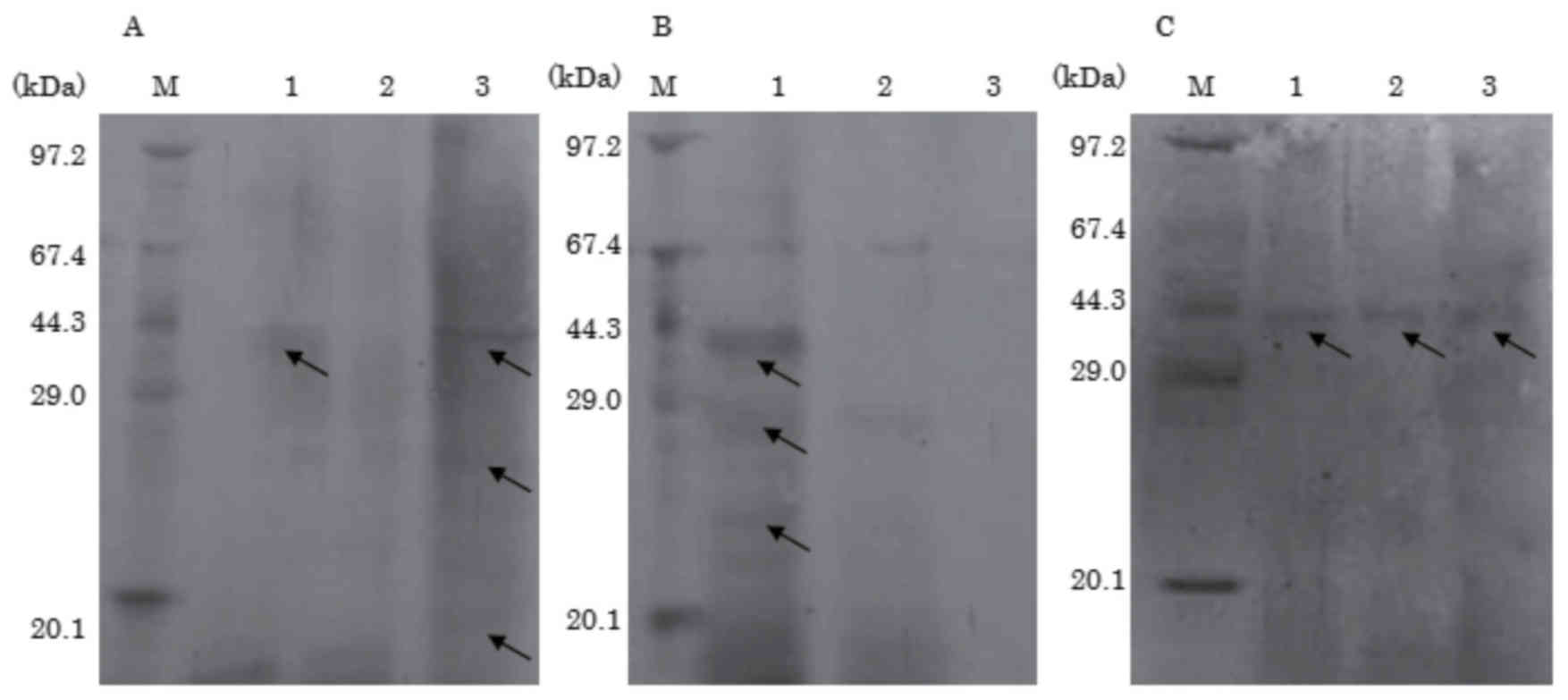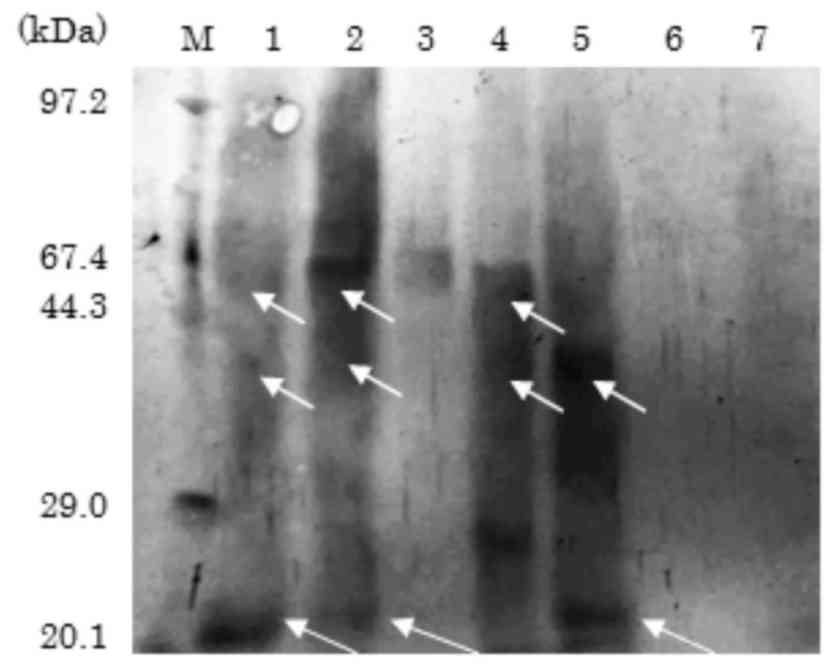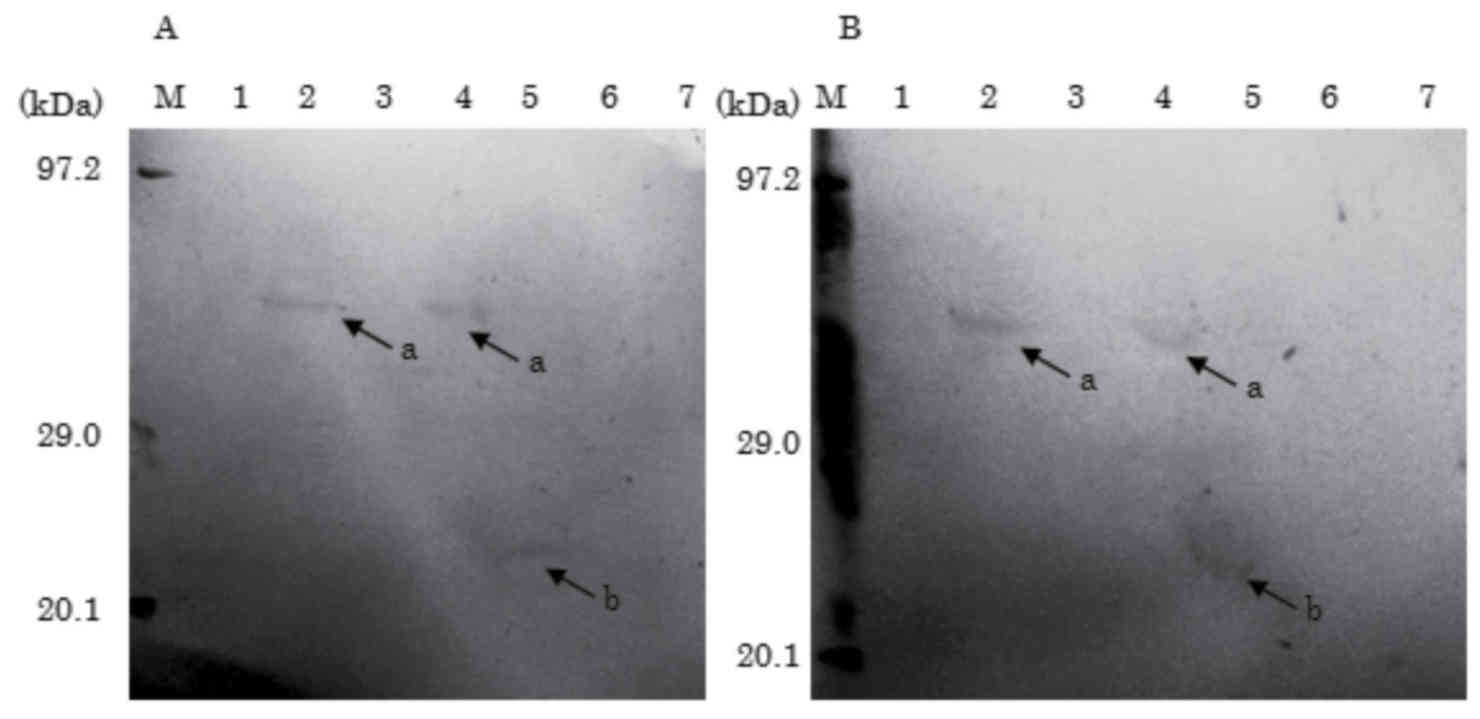Degradation and removal of soybean allergen in Japanese soy sauce
- Authors:
- Published online on: June 20, 2017 https://doi.org/10.3892/mmr.2017.6815
- Pages: 2264-2268
Abstract
Introduction
Soybean is one of the most important sources of dietary protein and lipid worldwide; however, soybean is also one of the commonest food allergens. An immunological study using the sera of patients with soybean allergies identified 16 immunoglobulin (Ig)E-binding components (1). Among them, Gly m Bd 68K, Gly m Bd 30K and Gly m Bd 28K proteins in the 7S globulin (β-conglycinin) fraction are considered to be the major soybean allergens (1). Gly m Bd 68K was identified as the α-subunit of β-conglycinin (2–4), which is main storage protein. Gly m Bd 30K was demonstrated to be the previously identified 34 kDa soybean seed vacuolar oil-body-associated glycoprotein P34, and a thiol protease family of the papain superfamily (1,5). Gly m Bd 28K is a glycoprotein with an asparagine-linked sugar moiety (1,6,7). In addition, Gly m 4 was reported that is related to cross reaction with pollenosis (8), and oleosin which is oil body membrane protein is reported as major allergen of sesame (9–12) and peanuts (9,12–14).
Soy sauce, or shoyu, is a traditional Japanese fermented seasoning that is available worldwide (15). In Japanese soy sauce, the two primary raw materials, soybeans and wheat, are used in roughly equal amounts. Naturally brewed soy sauce is prepared as presented in Fig. 1 (16–19). Briefly, the soybeans are steamed under conditions of high pressure and temperature, and wheat undergoes roasting and crushing. The soybeans and wheat are combined and a small amount of mold spores (Aspergillus oryzae or A. sojae) is added, and the mixture is subsequently placed on a large, porous plate. To provide optimal conditions for the growth of the mold and enzyme production, temperature- and moisture-controlled air is passed through the plate. Koji is the term used to describe the mold-cultured mixture, and the koji is subsequently mixed with water containing a high concentration of NaCl to produce a mash, which is termed moromi. The moromi is stored for several months in large tanks at room or an elevated temperature. During storage, the moromi is fermented with lactobacilli and yeasts, and is well aged. Following aging, the moromi is pressed and the liquid portion, which is referred to as raw soy sauce, is pasteurized by heat treatment. The heat-treatment process functions to deactivate microbial enzymes and to insolubilize the residual proteins in the raw soy sauce. The insoluble proteins are completely removed by filtration to obtain the final soy sauce product. During fermentation by microbial proteolytic enzymes, allergens from the raw materials are also degraded into peptides and amino acids; therefore, wheat and major soybean allergens (Gly m Bd 30K and Gly m Bd 28K) are not detected in soy sauce (19–22). However, soy sauce contains certain bioactive components, in addition to taste and aroma compounds; for example, certain polysaccharides, termed shoyu polysaccharides (SPS), originating from the cell wall of soybeans are resistant to enzymatic hydrolyses and remain even after fermentation (23). These SPS exhibit potent antiallergic activities (23–25), enhancing macrophage and lymphocyte functions (26), iron absorption promotion (27) and hypolipidemic effects (28) in vitro and in vivo.
The present study investigated the degradation of soybean proteins during fermentation and the presence of soybean allergens in commercial raw soy sauce in Japan by immunoblot analysis using anti-soybean protein antibody from rabbit and sera from 2 children with soybean allergy. The results demonstrated that soybean allergens remained in the raw soy sauce and were not completely degraded; soybean allergens were detected in 3 out of 7 commercial raw soy sauces in Japan. The soluble soybean allergens in raw soy sauce are denatured to insoluble allergens by heat treatment, and then removed by filtration. Therefore, in addition to the degradation of raw materials during fermentation, heat-treatment and filtration are very important processes for the low allergenicity of soy sauce.
Materials and methods
Soy sauce
Soy sauce was prepared by Higashimaru Shoyu Co. Ltd. (Tastuno, Japan) as previously described (19). To examine soybean proteins during the brewing of soy sauce, raw soy sauce (salt-soluble fractions of soy sauce) was obtained from each moromi at 2 weeks, 2 months and 6 months after fermentation has begun. The raw soy sauce liquid fraction was pressed from each moromi, and then raw soy sauce was pasteurized by heat-treatment at >85°C. The heat-treated soy sauce was centrifuged at 21,500 × g for 10 min to obtain a supernatant (the heat-treated soy sauce fraction). The solid portion remaining after centrifugation (the heat-denatured sedimentation product) was washed twice with 18% NaCl, and extracted with 0.1 M Tris-HCl buffer (pH 8.6) containing 4 M urea for 30 min (19), followed by centrifugation at 21,500 × g for 10 min to obtain the heat-denatured sedimentation fraction.
In addition, 7 items of commercial raw soy sauce in Japan (including 4 typical kinds of soy sauce: ‘Koikuchi’, dark soy sauce; ‘usukuchi’, light soy sauce; ‘tamari’, very dark soy sauce; and, ‘saishikomi’, refermented soy sauce) were also examined. Koikuchi is dark in color and made from equal amounts of soybeans and wheat. Usukuchi is also made from a mixture containing approximately equal amounts of soybeans and wheat; however, rice and gluten may also be added. The principles of the preparation of usukuchi and koikuchi are similar, but all the procedures are directed towards producing a lighter color in the final usukuchi product. Tamari is very dark in color and is made primarily from soybeans with a small quantity of wheat. Saishikomi is made from the moromi mash mixed with both the koji and raw soy sauce instead of more commonly used salt water.
Sera
The present study was approved by the institutional ethics committee of Higashimaru Shoyu Co., Ltd., and informed consent was obtained from each patient or her parents. Sera were obtained from 2 female patients (aged 11 and 9 years) with soybean allergy at the Department of Pediatrics, Kansai Medical University (Hirakata, Japan). The soybean-specific IgE titers of the patients were 1.01 and 10.9 IU/ml, respectively, as estimated with a radioallergosorbent test (RAST; CAP System FEIA, Pharmacia Diagnostics, Thermo Fisher Scientific, Inc., Uppsala, Sweden), the RAST score was 2–3 for soybean allergy according to the manufacturer's protocol. Sera were used for immunoblotting analysis following 50 fold dilution with distilled water.
Protein electrophoresis and immunoblotting
Proteins were separated by 14% SDS-PAGE according to the method described by Laemmli (29). To prevent thermal denaturation of samples, 20 µl of sample buffer [62.5 mM Tris-HCl (pH 6.8), 1% SDS, 5% 2-mercaptoethanol, 10% glycerol and 0.01% bromophenol blue] was added to 80 µl of soy sauce samples and incubated at 37°C overnight. The denatured sample was applied in 10 µl aliquots and the molecular weight marker used was Protein Molecular Weight Marker (Low; 3450; Takara Bio, Inc., Shiga, Japan). The gel was divided into 2 parts. Proteins separated on one part of the gel were stained with Coomassie Brilliant Blue R-250 dye (Quick-CBB for electrophoresis; Wako Pure Chemical Industries, Ltd., Osaka, Japan) and those separated on the other part of the gel were transferred electrophoretically onto a polyvinylidene difluoride membrane (AE-6666; Atto Corporation, Tokyo, Japan) for 1 h at a fixed current of 100 mA. For immunoblotting of soybean protein, the membrane was blocked overnight with 1% bovine serum albumin (BSA; FIA/RIA grade, essentially globulin free; Nacalai Tesque, Inc., Kyoto, Japan) in PBS-Tween-20 (0.1%; Sigma-Aldrich; Merck KGaA, Darmstadt, Germany) at 4°C. The proteins on the membrane were probed with primary rabbit anti-soybean protein polyclonal antibody (S2519; 1:5,000; Sigma-Aldrich; Merck KGaA) diluted with PBS-Tween-20 at 25°C overnight. After washing for 30 min with 1% BSA in PBS-Tween-20 (0.1%), the membrane was incubated with secondary biotinylated goat anti-rabbit IgG (PK-4001; Vectastain® ABC HRP Rabbit IgG kit; Vector Laboratories, Inc., Burlingame, CA, USA) following 5,000 fold dilution with PBS-Tween-20 (0.1%) at 25°C for 1 h, according to the manufacturer's protocol. After washing for 30 min with 1% BSA in PBS-Tween-20 (0.1%), the membrane was incubated with an avidin-biotinylated enzyme complex-peroxidase (PK-4001; Vectastain® ABC HRP Rabbit IgG kit; Vector Laboratories, Inc.) at 25°C for 30 min. After washing for 30 min with 1% BSA in PBS-Tween-20 (0.1%), detection was performed by the addition of 3,3′-diaminobenzidine tetrahydrochloride (DAB; SK-4100; DAB Peroxidase HRP Substrate kit; Vector Laboratories, Inc.), according to the manufacturer's protocol.
For immunoblotting of soybean allergen, the membrane (AE-6666; Atto Corporation) was blocked for 3 h with 1% BSA in PBS-Tween-20 (0.1%) at 4°C. The proteins on the membrane were probed with the sera of patients at 25°C for 3 h. After washing for 30 min with 1% BSA in PBS-Tween-20 (0.1%), the membrane was incubated with biotinylated goat anti-human IgE (BA-3040; Vector Laboratories, Inc.) at 25°C for 1 h, according to the protocol of this kit. After washing for 30 min with PBS-Tween-20 (0.1%), the membrane was incubated with the avidin-biotinylated enzyme complex-peroxidase at 25°C for 30 min, and subsequently washed for 30 min with 1% BSA in PBS-Tween-20 (0.1%). Detection was performed by the addition of DAB. All experiments were repeated ≥2 times.
Results and Discussion
Soybean protein degradation during soy sauce fermentation
To examine the degradation of soybean proteins during soy sauce fermentation, immunoblotting analyses of raw soy sauce from each moromi at 2 weeks, 2 months and 6 months of fermentation were performed using rabbit anti-soybean protein antibody. Soybean proteins from the raw materials are gradually degraded and solubilized during fermentation, but Gly m Bd 30K and partially degraded soybean proteins remained in raw soy sauce of the 6 months moromi and soybean proteins were not completely degraded even after fermentation (Fig. 2A). Following heat treatment (85°C) and filtration to separate it into the heat-treated soy sauce and the heat-denatured sedimentation fraction, no soybean protein was detected in the heat-treated soy sauce of the 6 months moromi, although soybean proteins (e.g., Gly m Bd 30K and partly degraded proteins) were detected in the heat-treated soy sauce of the 2 weeks and 2 months moromi (Fig. 2B). It was regarded as an effect of thermal denaturation that more soybean protein was detected in raw soy sauce compared with heat-treated soy sauce. In the heat-sedimentation fraction, soybean proteins were detected in the moromi at 2 weeks, 2 months and 6 months (Fig. 2C), indicating that the soluble soybean proteins were denatured to insoluble soybean proteins by heat-treatment and then removed completely by filtration.
Soybean allergens in commercial raw soy sauce
The majority of soy sauce produced in Japan is heat-treated; however, a certain amount of raw soy sauce is also produced. The present study investigated 7 commercially available raw soy sauce in Japan. Immunoblot analysis with the rabbit anti-soybean protein antibody detected soybean proteins in 4 of the 7 sauces, including 3 types of koikuchi (lanes 1, 2 and 4) and the saishikomi (lane 5; Fig. 3). Immunoblotting with the sera from two children with soybean allergy, detected soybean allergens in 3 of the 7 soy sauces, including 2 of the koikuchi (lanes 2 and 4) and the saishikomi (lane 5; Fig. 4). The molecular weight of soybean allergen detected in koikuchi of lane 2 and 4 was ~50 kDa and it was predicted to be the β-subunit of β-conglycinin. The soybean allergen detected in saishikomi of lane 5 was ~23 kDa and predicted to be oleosin. Gly m Bd 30K and Gly m Bd 28K were not detected, consistent with the results of previous studies (20–22).
In the current study, by using immunoblotting with the anti-soybean antibody and the sera from 2 children with soybean allergy, it was clearly demonstrated that soybean protein was not completely degraded in moromi and remained in the raw soy sauce. Furthermore, the soluble soybean proteins that remained in the raw soy sauce were denatured to insoluble allergens by heat-treatment and were completely removed from 6 month moromi by subsequent filtration. Soybean proteins were detected in certain commercial raw soy sauces (Fig. 3), and these soybean proteins were identified to be soybean allergens as they were immunostained by the sera from 2 children with soybean allergy. Notably, soybean allergens detected in commercial raw soy sauce were predicted to be the β-subunit of β-conglycinin and oleosin, which are not known as major soybean allergens. The β-subunit of β-conglycinin is highly homologous with the α-subunit, which is a major soybean allergen (3). Oleosin is a hydrophobic protein that is located in the outer layer of the oil body of plant cells, and is reported as an allergen in sesame (9–12) and peanuts (9,12–14). In conclusion, for soy sauce to have low allergenicity, heat-treatment and filtration are important processes for the removal soybean allergens, in addition to the enzymatic degradation in the moromi fermentation.
References
|
Ogawa T, Bando N, Tsuji H and Sasaoka K, Nishikawa K and Sasaoka K: Investigation of the IgE-binding proteins in soybeans by immunoblotting with the sera of the soybean-sensitive patients with atopic dermatitis. J Nutr Sci Vitaminol (Tokyo). 37:555–565. 1991. View Article : Google Scholar : PubMed/NCBI | |
|
Ogawa T, Bando N, Tsuji H, Nishikawa K and Kitamura K: Alpha-subunit of beta-conglycinin, an allergenic protein recognized by IgE antibodies of soybean-sensitive patients with atopic dermatitis. Biosci Biotechnol Biochem. 59:831–833. 1995. View Article : Google Scholar : PubMed/NCBI | |
|
Krishnan HB, Kim WS, Jang S and Kerley MS: All three subunits of soybean beta-conglycinin are potential food allergens. J Agri Food Chem. 57:938–943. 2009. View Article : Google Scholar | |
|
Adachi A, Horikawa T, Shimizu H, Sarayama Y, Ogawa T, Sjolander S, Tanaka A and Moriyama T: Soybean beta-conglycinin as the main allergen in a patient with food-dependent exercise-induced anaphylaxis by tofu: Food processing alter pepsin resistance. Clin Exp Allergy. 39:167–173. 2009. View Article : Google Scholar : PubMed/NCBI | |
|
Ogawa T, Tsuji H, Bando N, Kitamura K, Zhu YI, Hirano H and Nishikawa K: Identification of the soybean allergenic protein, Gly m Bd 30K, with the soybean seed 34-kDa oil-body-associated protein. Biosci Biotechnol Biochem. 57:1030–1033. 1993. View Article : Google Scholar : PubMed/NCBI | |
|
Tsuji H, Bando N, Hiemori M, Yamanishi R, Kimoto M, Nishikawa K and Ogawa T: Purification of characterization of soybean allergen Gly m Bd 28K. Biosci Biotechnol Biochem. 61:942–947. 1997. View Article : Google Scholar : PubMed/NCBI | |
|
Tsuji H, Hiemori M, Kimoto M, Yamashita H, Kobatake R, Adachi M, Fukuda T, Bando N, Okita M and Utsumi S: Cloning of cDNA encoding a soybean allergen, Gly m Bd 28K. Biochim Biophys Acta. 1518:178–182. 2001. View Article : Google Scholar : PubMed/NCBI | |
|
Kleine-Tebbe J, Vogel L, Crowell DN, Haustein UF and Vieths S: Severe oral allergy syndrome and anaphylactic reactions caused by a Bet v 1- related PR-10 protein in soybean, SAM2. J Allergy Clin Immunol. 110:797–804. 2002. View Article : Google Scholar : PubMed/NCBI | |
|
Morisset M, Moneret-Vautrin DA, Kanny G, Guénard L, Beaudouin E, Flabbée J and Hatahet R: Thresholds of clinical reactivity to milk, egg, peanut and sesame in immunoglobulin E-dependent allergies: Evaluation by double-blind or single-blind placebo-controlled oral challenges. Clin Exp Allergy. 33:1046–1051. 2003. View Article : Google Scholar : PubMed/NCBI | |
|
Chen JC, Lin RH, Huang HC and Tzen JT: Cloning, expression and isoform classification of a minor oleosin in sesame oil bodies. J Biochem. 122:819–824. 1997. View Article : Google Scholar : PubMed/NCBI | |
|
Leduc V, Moneret-Vautrin DA, Tzen JT, Morisset M, Guerin L and Kanny G: Identification of oleosins as major allergens in sesame seed allergic patients. Allergy. 61:349–356. 2006. View Article : Google Scholar : PubMed/NCBI | |
|
Pons L, Olszewski A and Guéant JL: Characterization of the oligomeric behavior of a 16.5 kDa peanut oleosin by chromatography and electrophoresis of the iodinated form. J Chromatogr B Biomed Sci Appl. 706:131–140. 1998. View Article : Google Scholar : PubMed/NCBI | |
|
Huang AHC: Oil bodies and oleosins in seeds. Ann Rev Plant Physiol Plant Mol Biol. 43:177–200. 1992. View Article : Google Scholar | |
|
Pons L, Chery C, Romano A, Namour F, Artesani MC and Guéant JL: The 18 kDa peanut oleosin is a candidate allergen for IgE-mediated reactions to peanuts. Allergy. 57 Suppl 72:S88–S93. 2002. View Article : Google Scholar | |
|
Yokotsuka T: Soy sauce biochemistry. Adv Food Res. 30:195–329. 1986. View Article : Google Scholar : PubMed/NCBI | |
|
Kobayashi M and Hayashi S: Modeling combined effects of temperature and pH on growth of Zygosaccharomyces rouxii in soy sauce mash. J Ferment Bioeng. 85:638–641. 1998. View Article : Google Scholar | |
|
Kobayashi M and Hayashi S: Supplementation of NaCl to starter culture of the soy yeast Zygosaccharomyces rouxii. J Ferment Bioeng. 85:642–644. 1998. View Article : Google Scholar | |
|
Nagai H, Kobayashi M, Tsuji Y, Nakashimada Y, Kakizono T and Nishio N: Biological and chemical treatment of solid waste from soy sauce manufacture. Water Sci Technol. 45:335–338. 2002.PubMed/NCBI | |
|
Kobayashi M, Hashimoto Y, Taniuchi S and Tanabe S: Degradation of wheat allergen in Japanese soy sauce. Int J Mol Med. 13:821–827. 2004.PubMed/NCBI | |
|
Tsuji H, Okada N, Yamanishi R, Bando N, Kimoto M and Ogawa T: Measurement of Gly m Bd 30K, a major soybean allergen, in soybean products by a sandwich enzyme-linked immunosorbent assay. Biosci Biotechnol Biochem. 59:150–151. 1995. View Article : Google Scholar : PubMed/NCBI | |
|
Ogawa T, Samoto M and Takahashi K: Soybean allergens and hypoallergenic soybean products. J Nutr Sci Vitaminol (Tokyo). 46:271–279. 2000. View Article : Google Scholar : PubMed/NCBI | |
|
Bando N, Tsuji H, Hiemori M, Yoshimizu K, Yamanishi R, Kimoto M and Ogawa T: Quantitative analysis of Gly m Bd 28K in soybean products by a sandwich enzyme-linked immunosorbent assay. J Nutr Sci Vitaminol (Tokyo). 44:655–664. 1998. View Article : Google Scholar : PubMed/NCBI | |
|
Kobayashi M, Matsushita H, Yoshida K, Tsukiyama R, Sugimura T and Yamamoto K: In vitro and in vivo anti-allergic activity of soy sauce. Int J Mol Med. 14:879–884. 2004.PubMed/NCBI | |
|
Kobayashi M, Matsushita H, Shioya I, Nagai M, Tsukiyama R, Saito M, Sugita T, Sugimura T and Yamamoto K: Quality of life improvement with soy sauce ingredients, shoyu polysaccharides, in perennial allergic rhinitis: A double-blind placebo-controlled clinical study. Int J Mol Med. 14:885–889. 2004.PubMed/NCBI | |
|
Kobayashi M, Matsushita H, Tsukiyama R, Saito M and Sugita T: Shoyu polysaccharides from soy sauce improve quality of life for patients with seasonal allergic rhinitis: A double-blind placebo-controlled clinical study. Int J Mol Med. 15:463–467. 2005.PubMed/NCBI | |
|
Matsushita H, Kobayashi M, Tsukiyama R and Yamamoto K: In vitro and in vivo immunomodulating activities of Shoyu polysaccharides from soy sauce. Int J Mol Med. 17:905–909. 2006.PubMed/NCBI | |
|
Kobayashi M, Nagatani Y, Magishi N, Tokuriki N, Nakata Y, Tsukiyama R, Imai H, Suzuki M, Saito M and Tsuji K: Promotive effect of Shoyu polysaccharides from soy sauce on iron absorption in animals and humans. Int J Mol Med. 18:1159–1163. 2006.PubMed/NCBI | |
|
Kobayashi M, Magishi N, Matsushita H, Hashimoto T, Fujimoto M, Suzuki M, Tsuji K, Saito M, Inoue E, Yoshikawa Y and Matsuura T: Hypolimidemic effect of Shoyu polysaccharides from soy sauce in animals and humans. Int J Mol Med. 22:565–570. 2008.PubMed/NCBI | |
|
Laemmli UK: Cleavage of structural proteins during the assembly of the head of bacteriophage T4. Nature. 227:680–685. 1970. View Article : Google Scholar : PubMed/NCBI |













